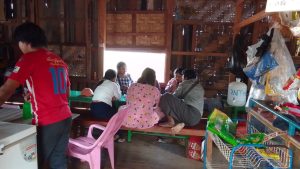The deportation of Myanmar nationals from the Indian northeastern state of Manipur could impact the ongoing war in Myanmar’s Sagaing Region, which has emerged as a hotspot of the conflict since the military coup three years ago.
Thirty-eight Myanmar nationals were deported from Manipur on May 2. With this, a total of 77 people, including 55 women and 5 children have been sent back to Myanmar in the first phase of deportations. Another 5,457 immigrants have been identified by the Manipur government for deportation soon.
The crackdown came in the wake of concerns expressed by the Manipur government and civil society organizations over the large-scale influx of “illegal immigrants” from Myanmar. There were allegations of Myanmar nationals being engaged in the illicit cultivation of poppy and deforestation in the state.
The Manipur government is also keen to resume fencing the state’s 247-mile-long border with Myanmar to prevent illegal immigration and cross-border criminal activities. So far, only around 9 km have been fenced. The fencing process was put on hold with local groups demanding that border disputes between the two neighbors must be resolved before undertaking the border fencing.
Manipur is contiguous to Myanmar’s Sagaing Region, which is among the areas worst affected by the ongoing civil war in the country. The military is on the back foot in many parts of the country and has been unable to regain lost territories. Resistance groups in Chin State and Kachin State, which also border India, have captured many military strongholds over the past couple of years.
In Sagaing Region, however, the military’s condition so far has not been as desperate as in other regions of Myanmar. This is despite the fact that experienced officers of the Kachin Independence Army (KIA) have been coordinating campaigns with the People’s Defense Forces (PDF) against the military over a vast region. The military has also been successful in regaining lost territories such as Kawlin, where the opposition National Unity Government (NUG) had established its own civilian administration.
A major factor contributing to the success of the resistance groups along a vast swathe of the India-Myanmar border regions is support from local groups in the Indian border states of Mizoram and Manipur. In Mizoram, assistance has been provided not only by the local populace and NGOs but also the state government, which has already voiced its opposition to the termination of the India-Myanmar Free Movement Regime (FMR) and to the fencing of the border. The support has taken different forms ranging from providing shelter, medicines and hideouts to organizing meetings and occasionally supplying weapons and explosives as evidenced by the seizures in Mizoram.
In Manipur, the support to Myanmar nationals and resistance groups has been offered mostly by the border populace. This was visible in the districts of Tengnoupal and Chandel when this correspondent visited these areas early last year. Besides refugees, resistance fighters of the Kuki, Chin and Burmese communities were found to have taken shelter in these districts.
Crossing the border into India put the resistance fighters beyond the reach of the Myanmar military or its local allies called Pyu Saw Htee, which was one of the reasons why the military could not take the upper hand in the conflict despite many battalions being pressed into action.
Now with the Manipur government adopting a tough stance and sending back Myanmar nationals, the option for resistance squads to sneak into the state is likely to draw to a close.
The most intense battle is in Myanmar’s border district of Tamu contiguous to Manipur’s Moreh where as many as eight People’s Defense Forces (PDFs) belonging to different communities are active. Control over Tamu is important for the military as it is linked to many cities, including Mandalay and Kalaymyo. The border town is also a major source of income for the military as it is a hub of smuggling and illicit activities.
The PDFs will have to firm up alternate strategies to continue the campaign against the regime troops as retreating to Manipur may no longer be viable. The junta has lost control over most of the country’s peripheral regions, with Rakhine State being the most recent example. The situation could pan out somewhat differently in the region bordering Manipur.
The junta’s efforts to establish full control over Tamu and the adjoining areas will likely continue in the coming months.

































